外研版(2019) 选择性必修第四册 Unit 5 Into the Unknown Developing ideas Reading课件 (31张)
文档属性
| 名称 | 外研版(2019) 选择性必修第四册 Unit 5 Into the Unknown Developing ideas Reading课件 (31张) | 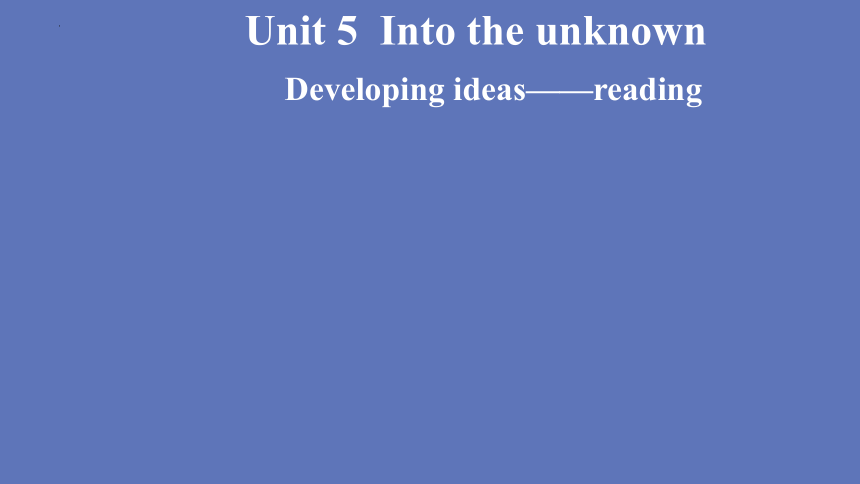 | |
| 格式 | zip | ||
| 文件大小 | 1.5MB | ||
| 资源类型 | 教案 | ||
| 版本资源 | 外研版(2019) | ||
| 科目 | 英语 | ||
| 更新时间 | 2022-08-03 10:20:08 | ||
图片预览


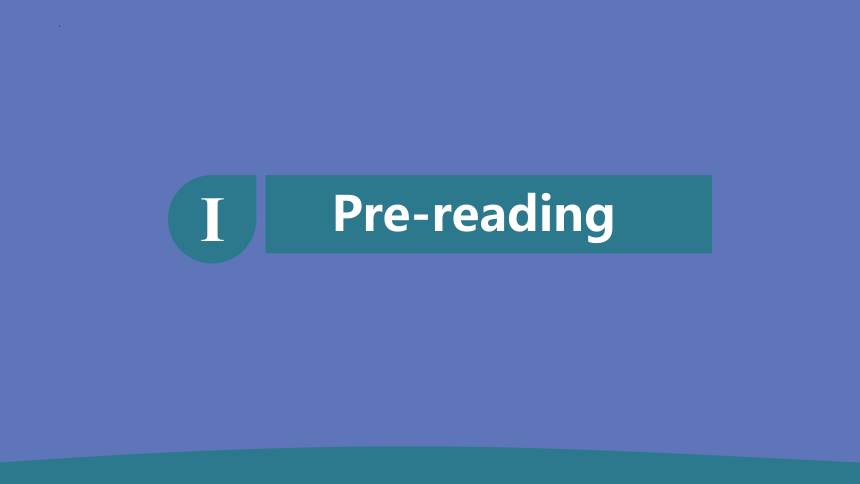

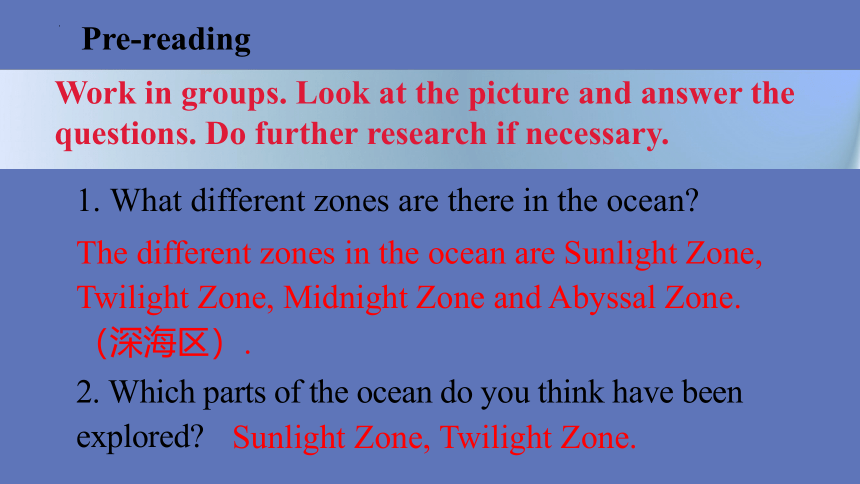
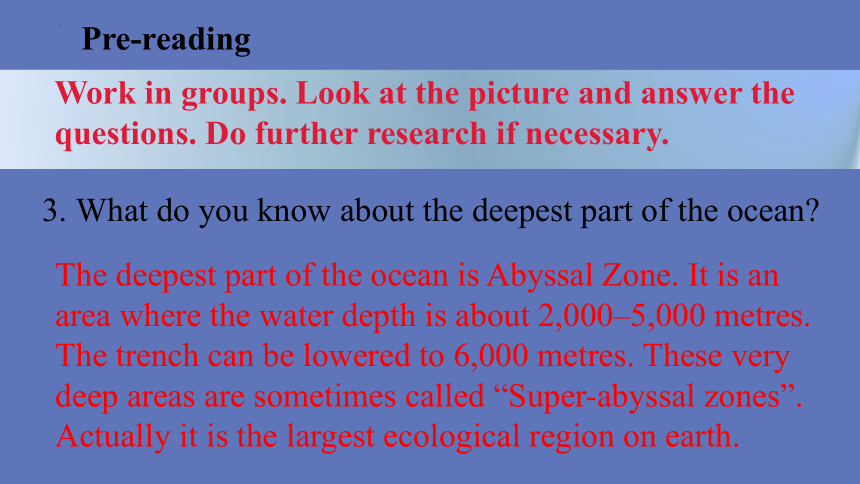
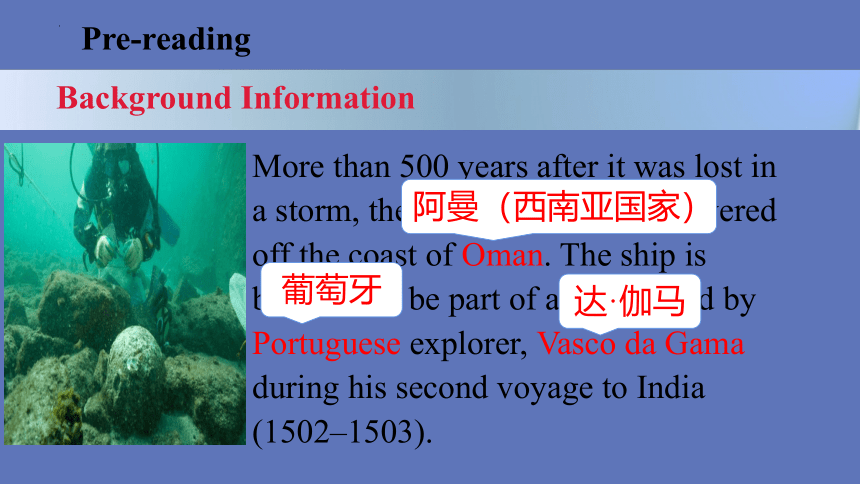
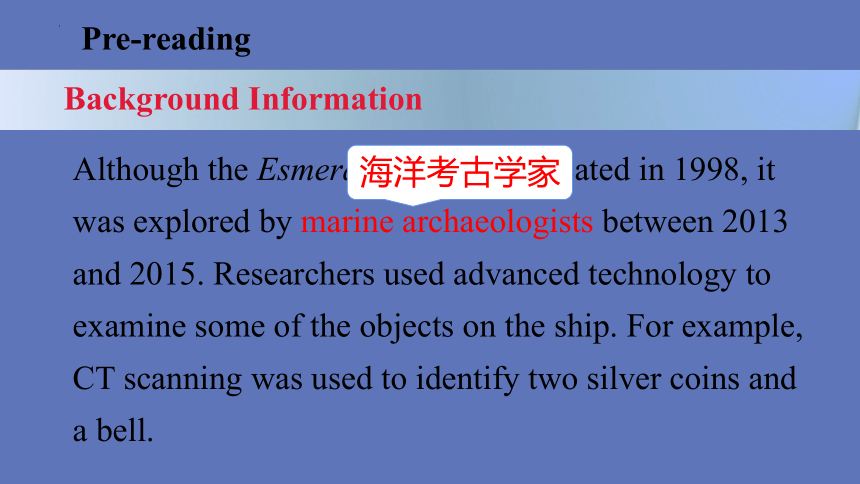
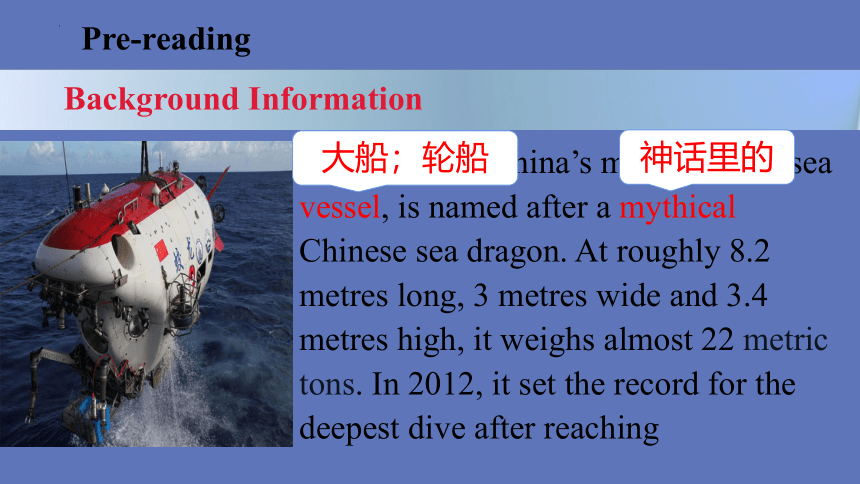
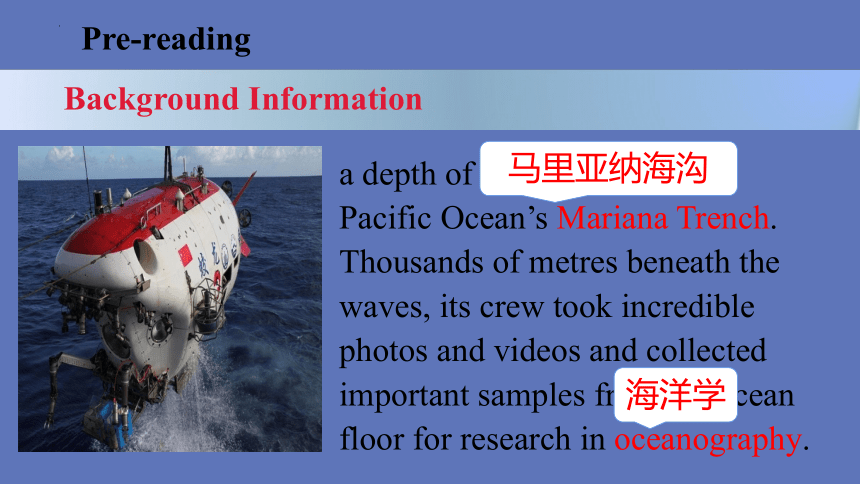

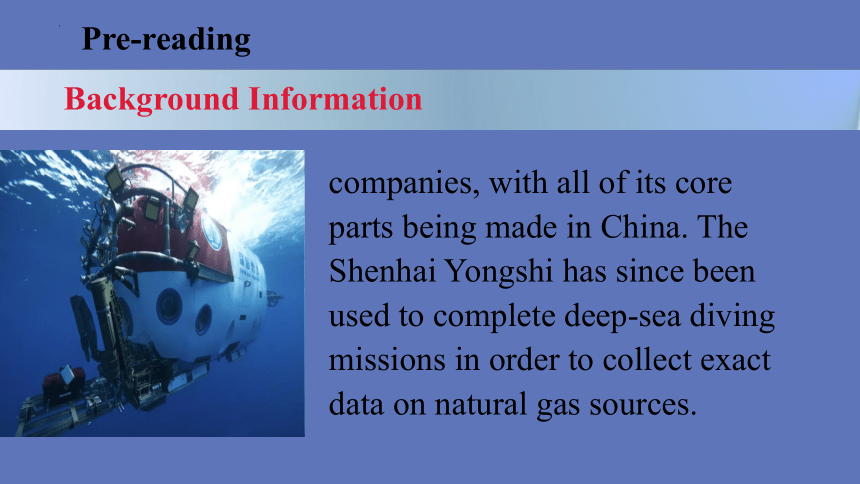
文档简介
(共31张PPT)
Developing ideas——reading
Unit 5 Into the unknown
目录
contents
Pre-reading
I
Language points
Ⅳ
Fast reading
II
Homework
Ⅴ
Intensive reading
III
Post-reading
Ⅵ
I
Pre-reading
Pre-reading
1. What different zones are there in the ocean
2. Which parts of the ocean do you think have been explored
3. What do you know about the deepest
part of the ocean
Work in groups. Look at the picture and answer the questions. Do further research if necessary.
Pre-reading
1. What different zones are there in the ocean
2. Which parts of the ocean do you think have been
explored
The different zones in the ocean are Sunlight Zone, Twilight Zone, Midnight Zone and Abyssal Zone.
(深海区).
Sunlight Zone, Twilight Zone.
Work in groups. Look at the picture and answer the questions. Do further research if necessary.
Pre-reading
3. What do you know about the deepest part of the ocean
The deepest part of the ocean is Abyssal Zone. It is an area where the water depth is about 2,000–5,000 metres. The trench can be lowered to 6,000 metres. These very deep areas are sometimes called “Super-abyssal zones”.
Actually it is the largest ecological region on earth.
Work in groups. Look at the picture and answer the questions. Do further research if necessary.
Pre-reading
More than 500 years after it was lost in a storm, the Esmeralda was discovered off the coast of Oman. The ship is believed to be part of a voyage led by Portuguese explorer, Vasco da Gama during his second voyage to India (1502–1503).
Background Information
阿曼(西南亚国家)
葡萄牙
达·伽马
Pre-reading
Although the Esmeralda was first located in 1998, it was explored by marine archaeologists between 2013 and 2015. Researchers used advanced technology to examine some of the objects on the ship. For example, CT scanning was used to identify two silver coins and a bell.
Background Information
海洋考古学家
Pre-reading
The Jiaolong, China’s manned deep-sea vessel, is named after a mythical
Chinese sea dragon. At roughly 8.2 metres long, 3 metres wide and 3.4
metres high, it weighs almost 22 metric tons. In 2012, it set the record for the deepest dive after reaching
大船;轮船
神话里的
Background Information
Pre-reading
a depth of 7,062 metres in the Pacific Ocean’s Mariana Trench. Thousands of metres beneath the waves, its crew took incredible photos and videos and collected important samples from the ocean floor for research in oceanography.
马里亚纳海沟
海洋学
Background Information
Pre-reading
The Shenhai Yongshi, or Deep Sea Warrior, is China’s deep-sea submersible, which can reach a depth of 4,500 metres. The submersible took 8 years and involved over 90 Chinese organisations and
潜水器
Background Information
Pre-reading
companies, with all of its core parts being made in China. The Shenhai Yongshi has since been used to complete deep-sea diving missions in order to collect exact data on natural gas sources.
Background Information
II
Fast reading
Read the passage and find out what has been discovered in the ocean depths.
Fast reading
Shipwrecks such as that of the Esmeralda, ruins of ancient cities like Neapolis, extraordinary deep-sea creatures such as bone-white coral and the barreleye, and the substance known as “fire ice” have been discovered in the ocean depths.
What has been discovered in the ocean depths
Fast reading
Shipwrecks such as that of the Esmeralda.
What has been discovered in the ocean depths
Evidence:
Para 1: Among these is the Esmeralda, the earliest
wreck from the age of the European exploration of
Asia.
Read the passage and find out what has been discovered in the ocean depths.
Fast reading
Ruins of ancient cities like Neapolis.
Evidence:
Para 2: One such find is the ancient Roman city of
Neapolis, discovered off the coast of Tunisia. Believed
to have been buried underwater by a tsunami in the
fourth century AD, the ruins of Neapolis are almost
2,000 years old.
Read the passage and find out what has been discovered in the ocean depths.
Fast reading
Extraordinary deep-sea creatures such as bone-white coral and the barreleye.
Evidence: Para 3: Imagine bone-white coral 6,000 metres below the ocean’s surface, growing at the rare of only one or two millimetres per year. Swimming through these black depths is the barreleye, a strange fish with eyes that can look upwards through its transparent forehead.
Read the passage and find out what has been discovered in the ocean depths.
Fast reading
The substance known as “fire ice”.
Evidence:
Para 4: Most notable of these is China’s discovery
of an ice-like substance, known as “fire ice”, under the South China Sea.
Read the passage and find out what has been discovered in the ocean depths.
III
Intensive reading
Intensive reading
Think about the structure of the passage and complete the diagram.
Intensive reading
OVER THE CENTURIES: sailing across oceans to explore Earth’s furthest corners
Ocean exploration
MODERN AGE: exploring 1___________
deep sea
Think about the structure of the passage and complete the diagram.
Intensive reading
2______________ exploration
Finding ancient ruins in 3_____________.
Working to overcome challenges and make
discoveries at 4__________.
Example:
5__________________
Archaeological
shallow waters
vast depths
the ruins of Neapolis
Think about the structure of the passage and complete the diagram.
Intensive reading
6 __________exploration
Containing about 90 per cent of 7_______________.
Helping comprehend 8_______________________
____________.
Examples:
9_______________ 10_____________
11_______________________________________
_________________
Biological
the planet’s fish
bone-white coral
the capacity for life on our
planet
the barreleye
life to be found even around the deep-sea
volcanic openings
Intensive reading
Discovery of natural resources
Discovering new natural resources.
Studying 12 __________.
Identifying areas for 13_______________.
Examples:
14__________
15_______________________
“fire ice”
deep-sea drilling
the sea bed
China’s underwater vessels
Think about the structure of the passage and complete the diagram.
1. Why do you think the author uses statistics in the passage
Intensive reading
The use of statistics makes the passage more convincing.
Intensive reading
2. What other examples of ocean exploration do you know of Share one with the class.
One possible answer: ①On 10 October, 2020, Endeavour successfully completed 13 dives in Mariana Trench, eight of which broke 10,000 metres. ②There is a growing interest in the construction of a network of undersea observatories, which is the most effective means of early warning earthquake and tsunami.
3. What do you think drives the exploration of the oceans
One possible answer: The oceans make up 70% of the earth’s total area. Large numbers of marine animals and plants are important sources of food for human beings. Therefore, it is very important for us to understand the world’s oceans. In addition to concerns about maritime security and economic interests, exploration of the seabed will satisfy human’s curiosity and thirst for the unknown knowledge.
Intensive reading
4. What common message do the two reading passages in this unit convey How do they each build upon this idea
Intensive reading
Both passages convey the message that humans have the desire and means to explore the unknown. The first passage does this by looking at our fascination with history’s greatest mysteries, while the second passage looks at pioneering exploration of Earth’s oceans.
Intensive reading
Learning to learn
As you read, notice the discourse markers used in the text, eg in addition, also, however, furthermore, as well as. These markers function like road signs, helping you connect ideas and understand the writer’s attitude and opinions.
话语标记语
Homework
VI
Homework
1. Search the Internet to know more about people’s oceanic explorations.
2. Write down your ideas about how to open up our planet’s final planet through closer scientific, economic and cultural operation.
Developing ideas——reading
Unit 5 Into the unknown
目录
contents
Pre-reading
I
Language points
Ⅳ
Fast reading
II
Homework
Ⅴ
Intensive reading
III
Post-reading
Ⅵ
I
Pre-reading
Pre-reading
1. What different zones are there in the ocean
2. Which parts of the ocean do you think have been explored
3. What do you know about the deepest
part of the ocean
Work in groups. Look at the picture and answer the questions. Do further research if necessary.
Pre-reading
1. What different zones are there in the ocean
2. Which parts of the ocean do you think have been
explored
The different zones in the ocean are Sunlight Zone, Twilight Zone, Midnight Zone and Abyssal Zone.
(深海区).
Sunlight Zone, Twilight Zone.
Work in groups. Look at the picture and answer the questions. Do further research if necessary.
Pre-reading
3. What do you know about the deepest part of the ocean
The deepest part of the ocean is Abyssal Zone. It is an area where the water depth is about 2,000–5,000 metres. The trench can be lowered to 6,000 metres. These very deep areas are sometimes called “Super-abyssal zones”.
Actually it is the largest ecological region on earth.
Work in groups. Look at the picture and answer the questions. Do further research if necessary.
Pre-reading
More than 500 years after it was lost in a storm, the Esmeralda was discovered off the coast of Oman. The ship is believed to be part of a voyage led by Portuguese explorer, Vasco da Gama during his second voyage to India (1502–1503).
Background Information
阿曼(西南亚国家)
葡萄牙
达·伽马
Pre-reading
Although the Esmeralda was first located in 1998, it was explored by marine archaeologists between 2013 and 2015. Researchers used advanced technology to examine some of the objects on the ship. For example, CT scanning was used to identify two silver coins and a bell.
Background Information
海洋考古学家
Pre-reading
The Jiaolong, China’s manned deep-sea vessel, is named after a mythical
Chinese sea dragon. At roughly 8.2 metres long, 3 metres wide and 3.4
metres high, it weighs almost 22 metric tons. In 2012, it set the record for the deepest dive after reaching
大船;轮船
神话里的
Background Information
Pre-reading
a depth of 7,062 metres in the Pacific Ocean’s Mariana Trench. Thousands of metres beneath the waves, its crew took incredible photos and videos and collected important samples from the ocean floor for research in oceanography.
马里亚纳海沟
海洋学
Background Information
Pre-reading
The Shenhai Yongshi, or Deep Sea Warrior, is China’s deep-sea submersible, which can reach a depth of 4,500 metres. The submersible took 8 years and involved over 90 Chinese organisations and
潜水器
Background Information
Pre-reading
companies, with all of its core parts being made in China. The Shenhai Yongshi has since been used to complete deep-sea diving missions in order to collect exact data on natural gas sources.
Background Information
II
Fast reading
Read the passage and find out what has been discovered in the ocean depths.
Fast reading
Shipwrecks such as that of the Esmeralda, ruins of ancient cities like Neapolis, extraordinary deep-sea creatures such as bone-white coral and the barreleye, and the substance known as “fire ice” have been discovered in the ocean depths.
What has been discovered in the ocean depths
Fast reading
Shipwrecks such as that of the Esmeralda.
What has been discovered in the ocean depths
Evidence:
Para 1: Among these is the Esmeralda, the earliest
wreck from the age of the European exploration of
Asia.
Read the passage and find out what has been discovered in the ocean depths.
Fast reading
Ruins of ancient cities like Neapolis.
Evidence:
Para 2: One such find is the ancient Roman city of
Neapolis, discovered off the coast of Tunisia. Believed
to have been buried underwater by a tsunami in the
fourth century AD, the ruins of Neapolis are almost
2,000 years old.
Read the passage and find out what has been discovered in the ocean depths.
Fast reading
Extraordinary deep-sea creatures such as bone-white coral and the barreleye.
Evidence: Para 3: Imagine bone-white coral 6,000 metres below the ocean’s surface, growing at the rare of only one or two millimetres per year. Swimming through these black depths is the barreleye, a strange fish with eyes that can look upwards through its transparent forehead.
Read the passage and find out what has been discovered in the ocean depths.
Fast reading
The substance known as “fire ice”.
Evidence:
Para 4: Most notable of these is China’s discovery
of an ice-like substance, known as “fire ice”, under the South China Sea.
Read the passage and find out what has been discovered in the ocean depths.
III
Intensive reading
Intensive reading
Think about the structure of the passage and complete the diagram.
Intensive reading
OVER THE CENTURIES: sailing across oceans to explore Earth’s furthest corners
Ocean exploration
MODERN AGE: exploring 1___________
deep sea
Think about the structure of the passage and complete the diagram.
Intensive reading
2______________ exploration
Finding ancient ruins in 3_____________.
Working to overcome challenges and make
discoveries at 4__________.
Example:
5__________________
Archaeological
shallow waters
vast depths
the ruins of Neapolis
Think about the structure of the passage and complete the diagram.
Intensive reading
6 __________exploration
Containing about 90 per cent of 7_______________.
Helping comprehend 8_______________________
____________.
Examples:
9_______________ 10_____________
11_______________________________________
_________________
Biological
the planet’s fish
bone-white coral
the capacity for life on our
planet
the barreleye
life to be found even around the deep-sea
volcanic openings
Intensive reading
Discovery of natural resources
Discovering new natural resources.
Studying 12 __________.
Identifying areas for 13_______________.
Examples:
14__________
15_______________________
“fire ice”
deep-sea drilling
the sea bed
China’s underwater vessels
Think about the structure of the passage and complete the diagram.
1. Why do you think the author uses statistics in the passage
Intensive reading
The use of statistics makes the passage more convincing.
Intensive reading
2. What other examples of ocean exploration do you know of Share one with the class.
One possible answer: ①On 10 October, 2020, Endeavour successfully completed 13 dives in Mariana Trench, eight of which broke 10,000 metres. ②There is a growing interest in the construction of a network of undersea observatories, which is the most effective means of early warning earthquake and tsunami.
3. What do you think drives the exploration of the oceans
One possible answer: The oceans make up 70% of the earth’s total area. Large numbers of marine animals and plants are important sources of food for human beings. Therefore, it is very important for us to understand the world’s oceans. In addition to concerns about maritime security and economic interests, exploration of the seabed will satisfy human’s curiosity and thirst for the unknown knowledge.
Intensive reading
4. What common message do the two reading passages in this unit convey How do they each build upon this idea
Intensive reading
Both passages convey the message that humans have the desire and means to explore the unknown. The first passage does this by looking at our fascination with history’s greatest mysteries, while the second passage looks at pioneering exploration of Earth’s oceans.
Intensive reading
Learning to learn
As you read, notice the discourse markers used in the text, eg in addition, also, however, furthermore, as well as. These markers function like road signs, helping you connect ideas and understand the writer’s attitude and opinions.
话语标记语
Homework
VI
Homework
1. Search the Internet to know more about people’s oceanic explorations.
2. Write down your ideas about how to open up our planet’s final planet through closer scientific, economic and cultural operation.
